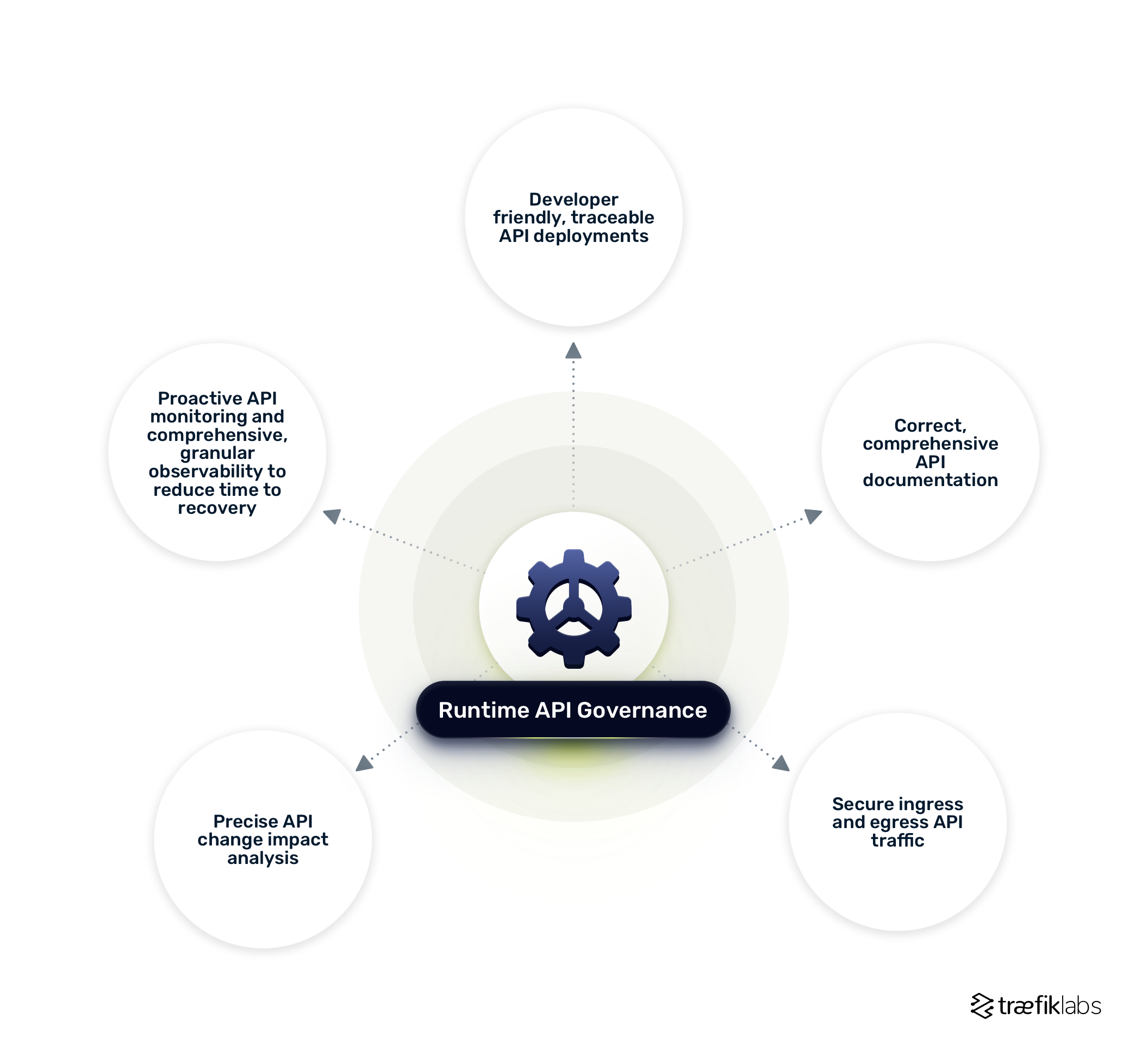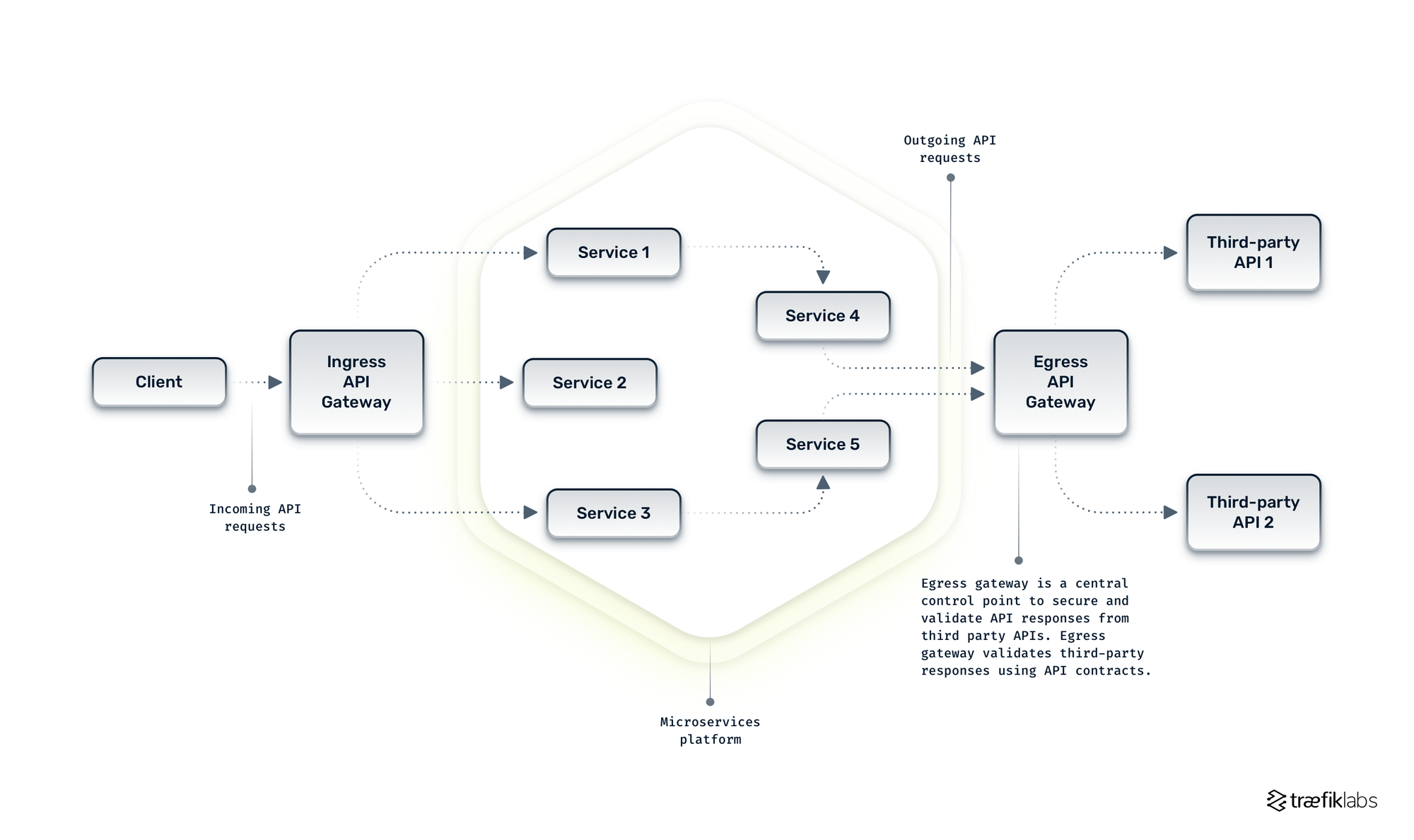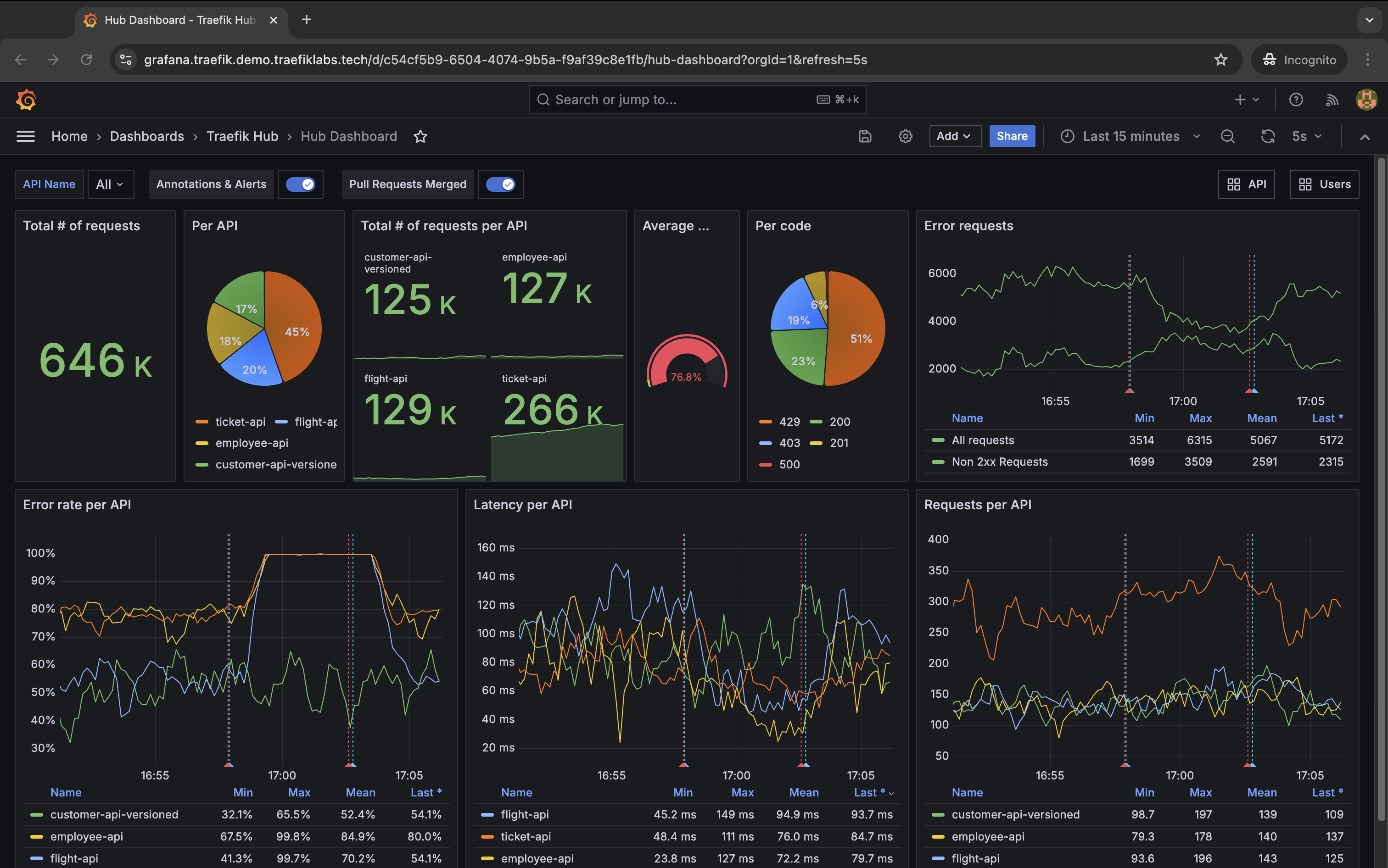Top Five Policies for Runtime API Governance

API governance provides a framework for defining policies and standards to ensure APIs are consistent, compliant, and secure. However, a common misconception about API governance is that it is solely about API design concerns, such as following a specified pagination pattern or ensuring API descriptions adhere to specific linting rules. While these design-time considerations are important, they’re only part of the picture. API governance is not just about defining design standards; it’s the backbone of ensuring that APIs are consistent, compliant, and secure across their entire lifecycle.
Overlooking runtime governance—like monitoring API performance, managing access controls, and enforcing security protocols—can lead to catastrophic failures in production. For instance, imagine a beautifully designed API that lacked proper runtime governance. Without robust security measures, attackers could exploit it, leading to data breaches and significant financial loss. Or consider an API with no runtime monitoring; a sudden surge in traffic could cause unanticipated outages, bringing down critical services and eroding user trust. Effective API governance addresses design and runtime concerns, ensuring that APIs meet standards during development and perform reliably and securely in the real world.
API management teams are responsible for defining and enforcing runtime API governance. Runtime API governance is the structured framework that manages and enforces policies for API deployment, security, observability, and lifecycle during their operational phase. It ensures APIs are deployed in a traceable and secure manner, with all configurations version-controlled and changes managed through a standardized process. This governance also mandates that live APIs be centrally documented, monitored for performance, and secured via gateways and firewalls. Overall, API governance provides a controlled environment to maintain API integrity, security, and efficiency in real-time operations.
Given how crucial API governance is to an organization’s API strategy's success, let's explore the topic further. In this post, we discuss five policies we recommend for API teams. They are listed below.
- Policy 1: Use a developer-friendly, traceable, and easy-to-rollback approach for API deployments
- Policy 2: Make comprehensive, correct API documentation available to users
- Policy 3: Secure ingress and egress API traffic from malicious and unauthorized access
- Policy 4: Provide precise API change impact analysis to minimize service failure and breaking changes
- Policy 5: Provide proactive API monitoring and comprehensive, granular observability to reduce time to recovery.
Each policy has one or more actionable standards that teams should adopt to meet these criteria.

Before we dive in, here is a note on the terminology we use in this post. By policy, we mean a high-level statement that requires compliance with one or more associated standards. A policy focuses on results and not implementation. On the other hand, by standards, we mean detailed mandatory, recommended, and optional rules used to gauge compliance with a given policy. Standards are specific and measurable, using capitalized keywords from IETF RFC-2119 (‘MUST’, ‘MUST NOT’, ‘SHOULD’, ‘SHOULD NOT’, ‘MAY’ etc.) to indicate the level of requirement compliance.
Policy 1: Use a developer-friendly, traceable, and easy-to-rollback approach for API deployments
The DORA metrics, Deployment Frequency (DF), Lead Time for Change (LTC), Change Failure Rate (CFR), and Mean Time to Recovery (MTTR), are widely used to assess a software team's performance. However, there's now an increased emphasis on developer experience and productivity. The State of Developer Experience Report 2024 revealed that 69% of developers are losing 20% or more of their time due to inefficiencies at work. The survey also explored the key areas that engineering leaders believe will enhance developer productivity and satisfaction. One of the top five areas identified was improving collaboration tooling.
When making changes to your API, it's crucial to have a deployment process that allows for fast deployment, easy experimentation, and the ability to roll back failed deployments and restore service quickly. Such a deployment process requires an automated deployment system to minimize manual errors. A deployment process like this is a key enabler for reducing LTC and improving software delivery performance. Additionally, the deployment process should facilitate seamless collaboration between development and operations teams and provide robust access controls to determine who can make changes. Furthermore, the process should also maintain an auditable history for traceability and accountability.
Here are three standards that can help realize this policy.
Governance Standard 1.1: All API descriptions and configuration MUST be version-controlled in Git
Managing API descriptions (like OpenAPI) and API configuration files (like Kubernetes Ingress manifests) in Git enables a workflow that provides a clear audit trail, giving a history of what was changed, when, and who changed it. This traceability makes it easier to troubleshoot changes and roll back a change that introduces a failure with a single Git revert command. It also enables developers to edit the files using editors, CLIs, and any preferred tool.
Governance Metric: The ratio of the organization's APIs whose configuration is under version control.
Governance Standard 1.2: All API configuration changes MUST follow a GitOps approach
GitOps has emerged as the modern way to manage application and infrastructure deployments. As part of the GitOps approach, the application state is managed in Git repositories, which act as the source of truth for the system's desired state. Application state is stored using declarative descriptions in formats like YAML and JSON. When the configuration files are updated, continuous delivery tools synchronize the application's live state with the desired state.
A GitOps approach allows for the fast delivery of API changes. Automated governance checks in the deployment pipeline enable organizations to achieve fast LTC and improved API consistency. Pull requests can be a lightweight governance technique to promote collaboration on changes. Teams following the GitOps approach disallow configuration changes from the application UI, eliminating error-prone TicketOps and ClickOps-based API deployments.
Governance Metric:
- Number of API configurations managed with GitOps.
- API config change review speed: The average time it takes from opening a config change PR to completing a review on it.
Governance Standard 1.3: The CI/CD pipeline MUST act as the primary change agent, driving all changes, feedback, and collaboration through automated processes, with no manual steps outside the pipeline.
A CI/CD pipeline should include all the necessary steps to validate and deploy working software to production. These steps involve compiling and packaging source code, conducting unit, integration, and acceptance tests, and deploying to progressively higher environments. In this way, the pipeline acts as both a central falsification mechanism and a primary change agent, ensuring that all changes, feedback, and collaboration are processed through automated workflows, with no manual intervention. If a new software change (that is, a commit) presents the hypothesis that “this change complies with standards and does not break working software,” then the CI/CD pipeline serves as a falsifiability test to evaluate that hypothesis.
By automating collaboration patterns, the pipeline ensures that feedback loops are consistent and transparent across teams. In this way, the CI/CD pipeline becomes not only an objective evaluator of changes but also a facilitator of cross-team feedback and collaboration. No manual steps should occur outside of the pipeline, ensuring that all changes and collaboration are fully automated and trackable. By automating previously manual processes, the pipeline evolves into an automated knowledge base that outlines the steps required to validate working software.
Such a pipeline has a profound effect on the team’s culture. Changing the pipeline changes the culture. Whenever a new standard is introduced, the team must first ask, “Is it possible to build this into the pipeline to solidify our expectations of collaboration from others?” The development team can refer to the pipeline logs when a build fails. The platform and infrastructure teams can use data produced by the pipeline to verify whether the software has been successfully deployed. The security team can review the security scan and testing results from the pipeline to validate a release candidate, and so on.
Governance Metric: % of changes validated through the pipeline vs. not
Policy 2: Make comprehensive and correct API documentation available to users
Large enterprises often struggle with API sprawl, which refers to the uncontrolled proliferation of APIs. API sprawl usually occurs when there is a lack of proper documentation and centralized API governance. Simply put, the organization may not know where all its APIs are located or what they are used for. API sprawl hinders integration and the exploitation of new business opportunities and poses a security risk. This risk can stem from Shadow APIs, which are used without the knowledge of the API governance teams and exist outside the established governance process. Additionally, the security risk can result from Zombie APIs that are no longer actively maintained, supported, or monitored but are still functional and accessible to users.
To combat API sprawl, a comprehensive API discovery mechanism should be implemented. API discovery is about making it easy for anyone in the organization to find any API they need. When people can locate the available APIs within an organization and understand what they do, it helps promote API consistency and reuse and reduces duplication of effort.
API documentation documents (that is, API descriptions like OpenAPI) also have to be comprehensive and accurate. Nothing produces an annoying user experience, and reduces trust in API providers, like available but inaccurate API documentation. Therefore it is important that runtime platforms are able to validate that API documentation matches the runtime traffic.
Governance Standard 2.1: Edge technologies SHOULD detect undocumented APIs
One way to manage API sprawl is to have policies and controls in place to detect undocumented and unmanaged APIs. Detecting APIs can be done by monitoring traffic at the edge. This detection can be one of the first steps for organizations suffering from API sprawl. From there, the organization can collate the documentation and store it in the internal API catalog, which leads to the next standard.
Apart from detecting undocumented APIs, runtime API platforms can also validate the correctness of API documentation by comparing it to run time traffic. This runtime validation mitigates API drift and is a security measure that identifies unexpected and potentially malicious API behaiviour.
Governance Metric:
- Number of unmanaged APIs detected by edge controls.
- Number of API description document defects
Governance Standard 2.2: All live APIs MUST be documented in a central API catalog
As part of your API deployment pipeline, API documentation should be stored centrally in an internal API catalog or registry. Additionally, a selection of these APIs can be made available to partners or consumers through an external developer portal. The catalog should have a browseable UI for users, but it should also provide API registry features. That is, it should provide the API descriptions for programmatic access by machines.
Governance Metric: The number of APIs in the API catalog.
Governance Standard 2.3: The API management platform SHOULD support self-service onboarding
Along with making APIs discoverable, users should be able to request and obtain access to an API quickly without jumping through administrative hoops. Self-service onboarding of APIs by obtaining an API key through a developer portal is one of the runtime requirements for a great developer experience for API users.
Governance Metric: Number of APIs documented in a self-service developer portal.
Policy 3: Secure ingress and egress API traffic from malicious and unauthorized access
The rapid growth of APIs and API traffic has exponentially expanded the attack surface for malicious actors. In its State of API Security Report 2024, Salt Security states that 95% of respondents in the research experienced security problems in production APIs, with 23% experiencing a breach. 25% of respondents also stated that one of their biggest concerns with their company’s API program was that it didn’t adequately address runtime or production API security.
It is crucial to protect APIs and invest in API runtime protection to guard against threats resulting from authentication weaknesses, sensitive data exposure, and account takeover or misuse. Public APIs can especially face a host of attack vectors—from SQL and code injection to cross-site scripting (XSS) and other OWASP Top 10 API vulnerabilities. They can also face bot attacks ranging from data scraping and intellectual property theft to account takeover and distributed denial of service (DDoS).
While organizations need to secure the APIs they build, they also consume APIs from third parties. These third-party APIs include APIs of external LLMs, CRM systems, payment processing platforms, messaging APIs, and more. However, the unsafe consumption of APIs is an OWASP API Security Top 10 threat. It arises when an application, such as an API, consumes external, third-party APIs and blindly trusts the data they return without adequately validating or sanitizing the data it receives. This exposes the application to SQL injection, code injection attacks, or the exposure of sensitive information.
Here are a few standards you can implement to achieve this policy in practice.
Governance Standard 3.1: All governed APIs SHOULD be exposed through an API gateway configured with appropriate security controls
API gateways provide control points for runtime API governance, enabling governance teams to enforce common runtime standards such as authentication and authorization, granular API access, rate limiting and throttling, input validation, and monitoring. API gateways can also integrate with an identity provider (IdP) to provide user authentication and authorization.
Governance Metric:
- The number of governed APIs not exposed through the gateway
- The number of APIs with insufficient authentication
Governance Standard 3.2: All public APIs MUST be protected by a WAF
A web application firewall (WAF) actively scans and filters incoming HTTP traffic. It blocks malicious API requests in real-time, typically using a set of threat signatures—pre-defined rules or patterns that identify malicious activity. In addition to maintaining a set of threat signatures, some WAFs use machine learning and behavioral analysis for pre-emptive protection, minimizing the need to update signatures when a new threat is identified continuously. WAFs may integrate with a global network of sensors to provide real-time threat intelligence on emerging threat patterns. WAFs can also provide detailed audit logs and reports required to meet various industry compliance requirements, such as PCI DSS, HIPAA, and GDPR.
Governance Metric: The number of public APIs unprotected by a WAF.
Governance Standard 3.3: Third-party API traffic MUST be validated
While organizations may put a lot of thought into securing the APIs they provide externally (such as encrypting the traffic and routing it through a gateway), they may not pay as much attention to the security of the APIs they consume. That is, API requests to third parties. Developers tend to trust the data from third-party APIs they consume, especially if they are provided by well-known companies. As such, they may adopt weaker security standards for API consumption.
A way to mitigate the security risk from third-party API traffic is to ensure third-party API traffic is encrypted, validated, and sanitized. Organizations can proxy the traffic through an API gateway that acts as an egress API gateway (also called a consumption gateway or reverse gateway). In the egress gateway, teams can use strong API contracts from the third party to validate that the traffic complies with the types, formats, and constraints defined in the contract. The egress gateway can also be a control point for implementing robust error handling and preventing the exposure of sensitive data. This egress gateway pattern is illustrated in the figure below.

Governance Metric: The number of unvalidated third-party APIs.
Policy 4: Provide precise API change impact analysis to minimize service failure and breaking changes
Change impact analysis involves identifying the potential consequences of a change, the components affected, and the possible risks associated with the change. It helps developers identify areas that can be affected by a change so that changes do not introduce system stability, performance, and security issues.
A way to analyze the impact of an API configuration deployment is to perform a static code analysis of the deployment artifacts. This analysis can help build a representation of a change and visualize its impact and any dependencies that may also be affected. For example, a static change analysis check may show that a rate limit change may affect not just one API but more. It may also show that changing a rate limit for a user group affects multiple groups. Such insights help reduce CFR.
Another way to analyze the impact of an API change is by detecting breaking changes, which can disrupt API users. A breaking change is a non-backward compatible change that forces API consumers to change their code to ensure their API integrations keep working.
Let’s look at two standards an organization can use to implement this runtime governance policy.
Governance Standard 4.1: All API configuration changes must pass static checks
One advantage of GitOps is that API configuration is stored in version control. This allows the team to run a static analysis on API configuration in the CI/CD pipeline. The analysis ensures that configuration files are valid and prevents any API misconfiguration from arising. It also helps the dev team understand the impact and scope of their changes on different APIs and API consumer groups.
Governance Metric: The ratio of the organization’s APIs whose configuration is under version control and change impact analysis checks.
Governance Standard 4.2: All APIs must follow the recommended versioning scheme
API versioning helps providers evolve an API and add new versions without breaking existing integrations. Many different versioning schemes exist for REST APIs (such as using the URI path, query parameters, custom headers, content type, and more). Your runtime infrastructure must support the versioning mechanisms that best fit your requirements. As an API provider, defining and adopting a consistent versioning mechanism for your APIs gives users a clear migration path to a new version and helps you manage the lifecycle of the API. Be sure to run breaking change checks before deployments to ensure no breaking changes are introduced.
Governance Metric: The number of APIs that do not follow the versioning scheme.
Policy 5: Provide proactive API monitoring and comprehensive, granular observability to reduce time to recovery
API monitoring involves tracking key metrics of API performance, such as response times and error rates. API Observability goes beyond monitoring a known set of API performance metrics. Observability allows API publishers to troubleshoot novel problems and understand what is happening inside an application. Observability is based on the ability of applications and infrastructure to emit telemetry signals: metrics, logs, and traces (MLT), which API publishers can analyze. API publishers can run distributed traces using telemetry, observing requests as they flow through a distributed system. This tracing gives them visibility into a system’s health and enables debugging the behavior of the production system.
API observability should be based on open standards for instrumenting, generating, collecting, and exporting telemetry data. Open observability standards like OpenTelemetry guarantee compatibility with various backend API analytics platforms and prevent vendor lock-in. They provide a way to decouple your observability strategy from your gateway strategy. Open standards also provide teams with a common language for describing cross-application interactions and troubleshooting.
Governance Standard 5.1: Teams MUST provide dashboards and configure alerts to monitor API request rate, error rate, and request latency
Having runtime visibility into an API’s performance is essential not only for understanding its usage but also for incident mitigation. API publishers should capture API metrics on uptime, requests per minute, latency, and errors per minute. They should also set up monitoring dashboards and proactive alerts to make API performance information available for the teams that support them.
Governance Metric: The number of APIs not set up for monitoring.
Governance Standard 5.2: APIs SHOULD use OpenTelemetry to publish telemetry data
OpenTelemetry is a widely supported open-source observability framework that has become the de facto standard for cloud-native applications. OpenTelemetry is built on rules and conventions known as the OpenTelemetry Protocol (OTLP). This protocol dictates how components related to OpenTelemetry exchange telemetry data between a source system that generates the data and its destination. The OTLP data model consists of traces, which describe the flow of execution; metrics, which offer statistical information on application performance; and logs, which provide detailed information on the application's state.
Governance Metric: The ratio of APIs instrumented with OpenTelemetry.
Governance Standard 5.3: API deployments SHOULD emit telemetry data
Application performance telemetry can be correlated with API deployment events to quickly visualize and investigate any API performance problems resulting from new deployments. Deployment event correlation with API runtime metrics is a powerful incident mitigation technique. This event correlation lets teams see if a deployment introduces problems and roll back the change.
Governance Metric: The ratio of API deployment pipelines that publish telemetry data.

Let's now explore how these runtime API governance policies are implemented in practice with Traefik Hub in Part 2 of this blog post.
In This Article




